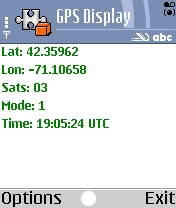So, tonight I took it upon myself to redo the javascript behind the map for the Open Guide to Boston. The reason for this is relatively simple: when I first wrote the Google Maps interface, the guide had about 50 nodes. With that in mind, drawing them all was acceptable. As the guide got bigger, it got a bit more time consuming, but was still much easier than paging. However, the guide has recently doubled in size as I’ve increased the rate at which I pull data from Zami.com (specifically for the purpose of trying to build a free database of all the churches in the area with user interaction) — up to 2400 nodes (making it the single largest Open Guide to date by pure node size, as far as I can tell).
With this change, the map was no longer just difficult to use: it was impossible. Attempting to open the page crashed my web browser.
So, I took it upon myself to learn enough JavaScript to do paging… but then decided that rather than paging, I should attempt a bit more friendly solution to start. So I started hacking, and got into the Google Maps getBoundsLatLng() function, which allows me to determine the area of the map.
There are two basic options to go from here, depending on performance you expect in various situations, and the scalability you want to have.
* Load all data. Create Javascript variables to store it all. When the map moves, iterate over the data, adding markers for only points which are not already visible, and are in the new span.
* Load only the original data from the database. All additional data to be loaded via XMLHttpRequest.
The first is obviously something that can be done entirely client side, and in fact turned out to be the (much easier than I expected) path I chose. The largest reason for this is simply ease of integration. OpenGuides code is rather convoluted (to me), and modifying it is not something that I enjoy spending a lot of time doing. I’ll do it when I need to, but I prefer to avoid it. The other option would be to simply query the database directly via Perl or some other language, without using the OG framework. This would probably be slightly faster, but with the size of data I’m using, iterating over it is a minimal time compared to the time drawing the GMaps Markers. As a result, I chose to go with the slower, less scalable, but quicker-to-implement and merge to other guides way of doing things. The biggest benefit here is that I can merge it back into the other quickly growing guides — Saint Paul is now growing leaps and bounds alongside Boston, due to help from pulling Zami.com’s database, and I plan to do similar things with other guides. Also, London probably will not be able to use the mapping stuff in any useful way without this kind of code being added, so I went for the quickest thing that could possibly work.
There were a few gotchas that I had to end up avoiding:
* Removing Google Maps Markers takes *much* longer than adding them. Like, 3-4 times longer in extremely informal testing. With one or two, or even 20-30, this doesn’t matter, but with 100, this starts to be a significant barrier to user interaction.
* There are a number of words which are reserved in Javascript, but are not treated that way in Firefox. This leads to confusing error messages in Safari (although they are slightly improved in the latest webkit): If you see a ParseError, you should check the Firefox Reserved Words list — this is in one of their bugs. For example, the variable “long” is reserved, and can not be used to pass something like, say, longitude.
Discovering the ParseError, working out why it was there, and how to fix it, was greatly helped by the #webkit folks: I have never seen a more dedicated, hardworking, friendly, open and inviting group of Open Source Software developers in my history as a programmer, either in closed or open source products. Many thanks to them for helping me work through why the error was happening, and how to avoid it in the future.
Lastly (although this is not quite chronological, as I did this first), I had to modify the code to the guide to zoom in father to start, so it wouldn’t try to load so many nodes. I think a next step is to allow users to set a default lat/long for themselves, a la Google Local, from which they can start browsing, rather than always dropping them into the main map. But that’s a problem for a nother late night hack session.
 If you’ve been asking this question, I’ve got software which has an answer for you.
If you’ve been asking this question, I’ve got software which has an answer for you.